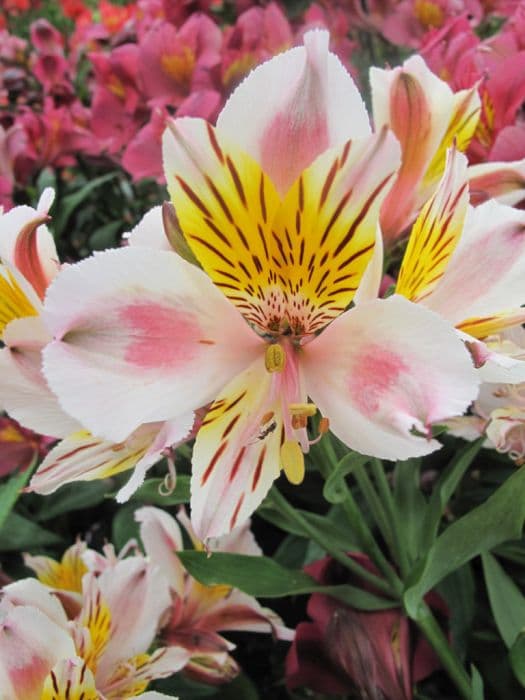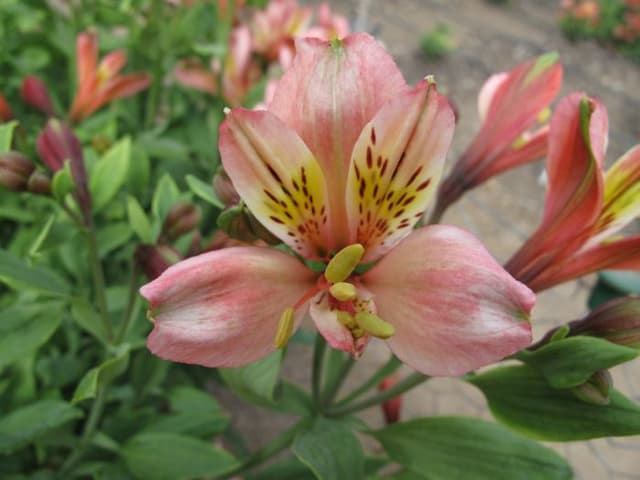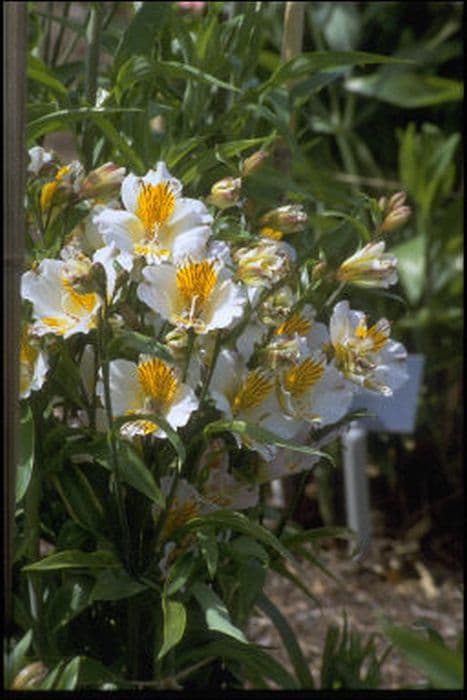Peruvian Lily Alstroemeria 'Evening Song'

ABOUT
Alstroemeria 'Evening Song', more commonly known as Peruvian Lily or Lily of the Incas, is a strikingly beautiful plant that produces an abundance of flowers. The blossoms of the 'Evening Song' are characterized by their rich colors, typically displaying a blend of deep burgundy and orange hues that converge into a fiery gradient, much like the colors of a sunset. Each flower petal is distinct, often adorned with streaks or specks of darker contrast, which may be brown or black, creating a dramatic effect. The arrangement of the petals is symmetrical and they fan out from a central point, giving the flower a balanced and harmonious appearance. The flowers themselves are clustered at the top of slender, upright stems, which are surrounded by lance-shaped leaves that have a fresh, green color. These leaves are slightly twisted or curled, adding texture to the plant's overall appearance. Peruvian Lilies are known for their long-lasting flowers, which makes them popular for cutting and using in floral arrangements. While they are in bloom, the 'Evening Song' variety can transform any garden space with its dynamic, warm-toned blossoms that can catch the eye from a distance. The foliage of the plant is dense, contributing to its lush, full look and providing a lovely backdrop for the stunning flowers.
About this plant
 Names
NamesFamily
Alstroemeriaceae
Synonyms
Peruvian Lily, Lily of the Incas, Parrot Lily
Common names
Alstroemeria 'Evening Song'
 Toxicity
ToxicityTo humans
The Peruvian lily is not considered highly toxic to humans, but it does contain compounds that can cause mild irritation. If any part of the plant is ingested, individuals might experience mild gastrointestinal upset, such as nausea or vomiting. Handling the plant might also cause skin irritation due to the presence of tuliposides, which can be allergens for some people.
To pets
The Peruvian lily is mildly toxic to cats and dogs. If a pet ingests any part of the plant, it may experience gastrointestinal symptoms such as vomiting, diarrhea, or drooling. The presence of tuliposides in the plant can lead to these adverse reactions. While it is not generally considered life-threatening, it is advisable to keep the Peruvian lily out of reach of pets to prevent discomfort and potential health issues. If a pet shows symptoms of poisoning, contact a veterinarian.
 Characteristics
CharacteristicsLife cycle
Perennials
Foliage type
Deciduous
Color of leaves
Green
Flower color
Mixed
Height
2-3 feet (0.6-0.9 meters)
Spread
1-2 feet (0.3-0.6 meters)
Plant type
Herb
Hardiness zones
7-10
Native area
South America
Benefits
 General Benefits
General Benefits- Long Blooming Season: Alstroemeria 'Evening Song' typically has an extended flowering period, providing color and aesthetic beauty for many months.
- Vibrant Colors: Its flowers boast a range of colors, often in captivating patterns, that can brighten up any garden space.
- Attracts Pollinators: The flowers can attract bees, butterflies, and hummingbirds, helping to pollinate other plants in the garden.
- Cut Flower Potential: Stems of this Peruvian lily are long-lasting when cut, making them a great addition to bouquets and floral arrangements.
- Drought Tolerance: Once established, it has a degree of drought resistance, reducing the need for frequent watering.
- Versatility in Landscaping: It can be used in a variety of garden settings, including borders, containers, and as ground cover.
- Low Maintenance: Aside from occasional deadheading and division, Alstroemeria 'Evening Song' is relatively easy to care for, without the need for extensive gardening expertise.
- Rapid Growth: This plant can grow quickly, allowing gardeners to enjoy its beauty soon after planting.
- Cold Tolerant: It can survive in cooler climates, making it suitable for a range of geographic locations.
- Resistant to Pests: Generally resistant to pests, this reduces the need for chemical treatments in the garden.
 Medical Properties
Medical PropertiesThis plant is not used for medical purposes.
 Air-purifying Qualities
Air-purifying QualitiesThis plant is not specifically known for air purifying qualities.
 Other Uses
Other Uses- Photography Prop: Alstroemeria, commonly known as Peruvian Lily or Lily of the Incas, can add a vibrant touch to floral photography setups, enhancing the composition with its striking colors and patterns.
- Artistic Inspiration: Artists may use the Peruvian Lily as a muse for paintings, drawings, and textile designs, inspired by its unique and intricate flower structure.
- Educational Tool: Biology educators can utilize the Peruvian Lily to explain plant reproductive systems, particularly the interesting way these flowers' reproductive parts twist and turn as they develop.
- Culinary Decoration: The petals of Alstroemeria can be used to add a splash of color to salads and desserts, although they are not commonly eaten.
- Theme Gardens: Peruvian Lilies are ideal for creating themed gardens such as a South American or tropical-inspired landscape, given their origin and vivid appearance.
- Crafting: Dried flowers of the Peruvian Lily can be used in crafting, for instance, in making bookmarks, greeting cards, or in scrapbooking for a natural embellishment.
- Symbolic Gestures: Due to their longevity and friendship connotations, they can be gifted to signify enduring relationships without resorting to the more common symbolism of flowers like roses.
- Color Dye: On a very experimental basis, the flowers of the Alstroemeria could be used to extract natural color dyes for use in artisanal craft projects.
- Performance Art: The stunning appearance of Peruvian Lilies can be integrated into performance art, particularly in costumes or set designs for their aesthetic appeal.
- Watercolor Subjects: Because of their diverse color palette and form, Peruvian Lilies make excellent subjects for watercolor artists looking to capture delicate details and vibrant hues.
Interesting Facts
 Feng Shui
Feng ShuiThe Peruvian lily is not used in Feng Shui practice.
 Zodiac Sign Compitability
Zodiac Sign CompitabilityThe Peruvian lily is not used in astrology practice.
 Plant Symbolism
Plant Symbolism- Friendship: Alstroemeria, commonly known as Peruvian lily or lily of the Incas, is often associated with strong bonds of friendship due to its intricate patterns that represent the interwoven connections between friends.
- Devotion: The long-lasting nature of the Peruvian lily's blooms symbolizes the enduring commitment and mutual support found in devoted relationships.
- Prosperity: With its abundant flowers and vibrant colors, the Peruvian lily is also seen as a token of wealth and prosperity.
- Achievement: The resilient and adaptive qualities of this plant signify the achievement of personal success through persistence and hard work.
- Fortune: The Peruvian lily is sometimes given to wish good fortune upon others, extending blessings for positive outcomes in their endeavors.
 Water
WaterPeruvian lilies, including the 'Evening Song' variety, should be watered thoroughly, ensuring the soil is moist but not waterlogged. Typically, watering once a week with about 1 to 1.5 gallons of water is sufficient. During hotter and drier periods, you may need to water more frequently, possibly twice a week, to maintain consistent soil moisture. It’s crucial to reduce watering in the winter when the plant is dormant. Always check the top inch of soil for dryness before watering again.
 Light
LightPeruvian lilies, such as 'Evening Song', thrive in bright, indirect sunlight. They perform best when placed in a location that receives morning sunlight and dappled or partial shade in the afternoon. Direct, harsh sunlight can damage the foliage and blooms, so it’s important to find a spot that provides some protection during the peak sun hours.
 Temperature
TemperaturePeruvian lilies, including 'Evening Song', prefer temperatures between 65 to 75 degrees Fahrenheit. They can tolerate a minimum temperature of 45 degrees Fahrenheit and a maximum of around 80 degrees Fahrenheit. To ensure healthy growth, it’s best to protect the plants from extreme heat or cold.
 Pruning
PruningPeruvian lilies, such as 'Evening Song', benefit from pruning to remove spent flowers and encourage new growth. Prune the stems back to the ground after flowering to maintain a tidy appearance and promote healthy, vigorous plants. The best time for pruning is late fall or early spring.
 Cleaning
CleaningAs needed
 Soil
SoilPeruvian Lily 'Evening Song' thrives in fertile, well-drained soil with a slightly acidic to neutral pH of 6.5 to 7. A good soil mix would be one part garden soil, one part peat or compost, and one part perlite or sand to enhance drainage.
 Repotting
RepottingPeruvian Lily 'Evening Song' should be repotted every 2 to 3 years or when the root system outgrows the pot, usually in the spring just before the growing season begins for optimal health.
 Humidity & Misting
Humidity & MistingPeruvian Lily 'Evening Song' prefers moderate humidity levels, ideally between 40-60%. Avoid excessively dry air which may lead to desiccation of the foliage.
 Suitable locations
Suitable locationsIndoor
Place Peruvian Lily in bright, indirect light, away from drafts.
Outdoor
Plant in partial sun, sheltered from harsh afternoon rays.
Hardiness zone
7-10 USDA
 Life cycle
Life cycleThe Peruvian Lily 'Evening Song' begins its life as a tuberous rhizome, which, when placed in well-draining soil and with adequate warmth, will sprout and produce roots and shoots. The shoots grow into stems that bear lance-shaped, dark green leaves and eventually give rise to the flower clusters for which the plant is known, typically in late spring to summer. After blooming, which may last several weeks, the flower petals wilt and the plant focuses on seed production if pollination has occurred, although many cultivators propagate through division rather than seeds. Post-blooming, energy is redirected to the rhizomes, which store nutrients for the next growing season. As autumn approaches, the above-ground foliage begins to die back as the plant enters dormancy, especially in regions with cooler climates. With the return of warmer weather in spring, the cycle reinspires as new growth emerges from the overwintered rhizomes.
 Propogation
PropogationPropogation time
Spring-Early Summer
Alstroemeria 'Evening Song', commonly known as Peruvian Lily or Lily of the Incas, is best propagated through division, a method that allows growers to multiply their plants while maintaining the characteristics of the parent plant. The optimal time for the division is early spring or late fall when the plant is either coming out of dormancy or going into it. To propagate by division, carefully dig up the tuberous roots of the plant, making sure to minimize damage. Then, using a sharp, clean knife or spade, split the clump into smaller sections, ensuring that each piece has at least one or two growth points or eyes. These sections can then be replanted in well-draining soil, spaced about 12 to 18 inches apart (30 to 45 cm), and at a depth such that the growth points are just below the soil surface. Water the new divisions well to help establish them. This method is simple and effective, making it the most popular way of propagating Peruvian Lilies.


![Peruvian lily [Inca Glow]](/_next/image?url=https%3A%2F%2Fplants-admin.emdemapps.com%2Fimages%2Fplants%2F%2Fimages%2F604b5e99e48d9.png&w=640&q=75)
![Peruvian lily [Inca Smile]](/_next/image?url=https%3A%2F%2Fplants-admin.emdemapps.com%2Fimages%2Fplants%2F%2Fimages%2F604b5cad8fa91.png&w=640&q=75)
![Peruvian lily [Inticancha Passion]](/_next/image?url=https%3A%2F%2Fplants-admin.emdemapps.com%2Fimages%2Fplants%2F%2Fimages%2F604b5f7a78c8d.png&w=640&q=75)


![Peruvian lily [Summer Breeze]](/_next/image?url=https%3A%2F%2Fplants-admin.emdemapps.com%2Fimages%2Fplants%2F%2Fimages%2F604b6401573b7.png&w=640&q=75)

